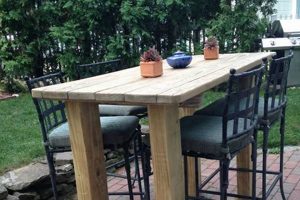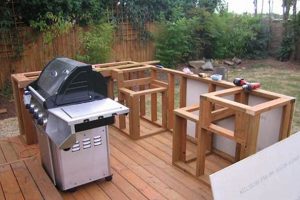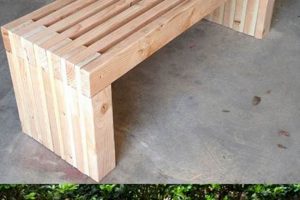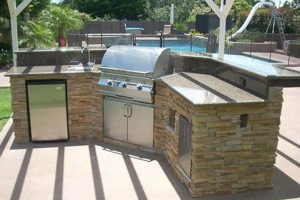The construction of a personal heat bathing structure in an exterior setting through self-directed effort represents a significant undertaking. This process typically involves procuring materials, adhering to safety standards, and implementing construction techniques appropriate for elevated temperature environments. Examples range from repurposing existing sheds to building entirely new structures designed specifically for sauna use.
Establishing such a facility provides convenient access to therapeutic heat, potentially offering relaxation and purported health benefits. Historically, these structures have played roles in cleansing rituals and social gatherings across various cultures. The creation of ones own, rather than relying on commercial establishments, allows for customization of size, heating method, and aesthetic design to suit individual preferences and spatial constraints.
Further discussion will elaborate on crucial considerations for design, material selection, heating system options, and essential safety precautions necessary for the successful completion of the project. Detailed information on permitting requirements and ongoing maintenance strategies will also be presented to ensure the longevity and safe operation of the finished structure.
Construction Advice for Exterior Heat Bathing Structures
The following recommendations offer guidance toward the successful completion of a personal exterior heat bathing project. Careful consideration of each point will contribute to the safety, efficiency, and longevity of the structure.
Tip 1: Proper Foundation Preparation: A solid and level foundation is paramount. Utilize concrete piers or a gravel pad to ensure stability and prevent moisture damage. The selected foundation should adequately support the weight of the structure and its occupants.
Tip 2: Material Selection for Heat Resistance: Opt for wood species known for their resistance to heat and decay, such as cedar, redwood, or hemlock. Avoid treated lumber within the interior due to potential off-gassing at elevated temperatures.
Tip 3: Ventilation Considerations: Adequate ventilation is crucial for air circulation and moisture removal. Incorporate both intake and exhaust vents strategically positioned to promote even heating and prevent the buildup of harmful gases.
Tip 4: Heating System Selection and Installation: Choose a heating system appropriate for the size of the structure and user preferences. Electric heaters offer convenience, while wood-burning stoves provide a traditional experience. Ensure compliance with all local fire codes and safety regulations during installation.
Tip 5: Insulation for Energy Efficiency: Proper insulation minimizes heat loss, reducing energy consumption and maintaining consistent temperatures. Utilize heat-resistant insulation materials and ensure a tight seal to prevent air leaks.
Tip 6: Seating and Ergonomics: Design seating arrangements that are comfortable and safe. Consider varying bench heights to accommodate different temperature preferences. Ensure adequate headroom and clearance around the heating unit.
Tip 7: Weatherproofing and Exterior Protection: Apply a weather-resistant sealant or stain to the exterior to protect the wood from the elements. Regular maintenance will prolong the lifespan of the structure and prevent deterioration.
Adherence to these suggestions will significantly enhance the safety and enjoyment of the personal exterior heat bathing experience. Prioritizing sound construction principles and informed material selection is essential for long-term success.
The subsequent section will address regulatory requirements, ongoing maintenance procedures, and advanced customization options for a personal heat bathing structure.
1. Structural Integrity
The structural integrity of a self-constructed exterior heat bathing structure is paramount for its safe and prolonged operation. The elevated temperatures and fluctuating humidity levels inherent to sauna environments place significant stress on building materials. Compromised structural components can lead to instability, collapse, and potential injury to occupants. Therefore, careful attention to design, material selection, and construction techniques is non-negotiable.
Consider the scenario of a DIY sauna built with an inadequate foundation. Over time, ground movement and settling can cause walls to shift, compromising the airtight seal essential for efficient heating. Similarly, using untreated lumber susceptible to rot can lead to structural weakening due to moisture intrusion. The roof structure must withstand snow loads and wind forces, requiring robust framing and secure connections. Proper joinery techniques, such as mortise and tenon or appropriately sized screws and brackets, are critical for ensuring the long-term stability of the structure. Furthermore, the heating unit, whether wood-fired or electric, adds weight and can vibrate, potentially weakening surrounding supports if not adequately reinforced.
In summary, neglecting structural integrity when building a personal exterior heat bathing structure directly translates to increased risk of failure and potential harm. A rigorous approach to design, focusing on load-bearing capacity, material durability, and proper construction methods, is essential for creating a safe, functional, and enduring recreational amenity. A sound structure provides a safe and enjoyable experience for years to come.
2. Thermal Efficiency
Thermal efficiency represents a critical factor in the performance and operational costs of a self-constructed exterior heat bathing structure. It dictates the rate at which heat is lost to the surrounding environment, directly influencing the energy required to maintain the desired temperature. Poor thermal efficiency translates into increased fuel consumption for wood-burning models or higher electricity bills for electric units. Inefficient heat retention also compromises the user experience, requiring longer preheating times and potentially leading to inconsistent temperature distribution within the structure.
The design and material selection significantly impact thermal performance. For instance, a structure lacking adequate insulation in the walls and roof will experience substantial heat loss through conduction. Gaps or cracks in the wall construction allow for convective heat loss via air leakage. A real-world example involves two identical structures; one insulated with fiberglass batts and the other left uninsulated. The insulated unit reaches the desired temperature in half the time and consumes significantly less energy to maintain it. The choice of materials, such as dense, low-conductivity wood species and properly sealed windows and doors, further contributes to minimizing heat transfer. Strategic placement of the structure, sheltered from prevailing winds, also helps to reduce convective heat loss.
In conclusion, achieving optimal thermal efficiency in an exterior heat bathing structure requires a comprehensive approach encompassing careful design, appropriate material selection, and meticulous construction practices. Addressing heat loss through conduction, convection, and radiation is essential for minimizing energy consumption, reducing operational costs, and maximizing user comfort. Prioritizing thermal performance contributes significantly to the overall value and long-term sustainability of the project.
3. Ventilation Adequacy
Ventilation adequacy in self-constructed exterior heat bathing structures directly impacts user safety and structural longevity. The high temperatures and humidity levels characteristic of these environments necessitate a consistent exchange of air to prevent the buildup of harmful gases, such as carbon dioxide, and to mitigate the risk of excessive moisture accumulation. Inadequate ventilation can lead to adverse health effects, including dizziness, nausea, and, in extreme cases, asphyxiation. Furthermore, insufficient airflow fosters the growth of mold and mildew, accelerating the deterioration of wooden components and compromising the structural integrity of the building. A properly designed ventilation system ensures a constant supply of fresh air, diluting harmful contaminants and removing excess moisture.
A practical example illustrates this point. Consider two identical DIY saunas: one with strategically placed intake and exhaust vents, and the other lacking any dedicated ventilation. The poorly ventilated structure exhibits a noticeable musty odor, and users report experiencing discomfort and difficulty breathing after only a short period of use. Upon inspection, signs of mold growth are evident on the walls and ceiling. Conversely, the adequately ventilated structure maintains a clean, fresh atmosphere, and users can comfortably enjoy extended sessions. The carefully positioned vents facilitate a natural convection current, drawing cool air in near the floor and expelling warm, moisture-laden air through vents near the ceiling. The choice of ventilation strategy, whether passive or active, dictates the rate of air exchange and should be tailored to the size and usage patterns of the structure. Moreover, the location of the air intake is crucial, ensuring that fresh air is drawn from a clean source, free from contaminants such as exhaust fumes or stagnant water.
In summary, ventilation adequacy is not merely an optional consideration but a fundamental requirement for safe and sustainable operation. Neglecting this aspect compromises user health and accelerates structural degradation. A well-designed and properly functioning ventilation system is essential for maintaining a comfortable and healthy environment within a self-constructed exterior heat bathing structure, contributing significantly to its long-term value and enjoyment.
4. Heating System Safety
The safe operation of the heating system is a non-negotiable aspect of any self-constructed exterior heat bathing structure. The selection, installation, and maintenance of the heating apparatus present significant potential hazards if not approached with meticulous attention to detail and adherence to established safety standards. Failures in this domain can result in fire, burns, carbon monoxide poisoning, and electrical shock, posing grave risks to occupants and the surrounding environment. The heating system, typically either wood-fired or electric, constitutes the core element responsible for generating the intense heat characteristic of the structure, and its malfunction carries severe consequences.
Consider the case of a wood-fired heating system installed with inadequate clearances from combustible materials. Over time, prolonged exposure to radiant heat can ignite nearby wood framing, resulting in a catastrophic fire. Similarly, an improperly vented wood-burning stove can release dangerous levels of carbon monoxide into the enclosed space, leading to potentially fatal poisoning. With electric systems, faulty wiring or a lack of proper grounding can create electrical shock hazards. The use of undersized wiring can result in overheating and fire. All electrical connections must be made in accordance with local electrical codes and inspected by a qualified electrician. Regularly inspecting the heating system for signs of wear, damage, or corrosion is also vital. Chimneys must be cleaned periodically to prevent creosote buildup, and electrical components must be tested for proper function. Implementing readily accessible fire extinguishers and carbon monoxide detectors further enhances safety. Therefore, prioritizing safe operating procedures for the heating apparatus minimizes risk and provides peace of mind.
In conclusion, heating system safety constitutes a critical determinant of the overall safety and usability of a personal, exterior heat bathing facility. Addressing potential hazards through proper installation, regular maintenance, and adherence to safety protocols is essential for preventing accidents and ensuring the well-being of occupants. A commitment to safety safeguards the structure and contributes to the sustained enjoyment of the recreational experience. Without prioritizing it, potential outcomes can be hazardous.
5. Material Durability
Material durability directly impacts the longevity and safety of any do-it-yourself exterior heat bathing structure. The elevated temperatures and high humidity levels inherent to sauna environments accelerate material degradation. This necessitates the selection of materials specifically suited to withstand these conditions to avoid premature failure and potential hazards. The cause-and-effect relationship is clear: unsuitable materials lead to rapid deterioration, while durable materials prolong the lifespan of the structure. Material durability is not merely an aesthetic concern; it is a fundamental component influencing structural integrity and occupant safety. For example, using untreated pine for interior paneling will result in warping, cracking, and eventual rot due to moisture absorption, whereas cedar or redwood, with their natural resistance to decay, provide a far more durable solution.
The practical significance extends to operational costs. While less durable materials may offer initial cost savings, their shorter lifespan translates into more frequent repairs and replacements, ultimately increasing the overall expenditure. Conversely, investing in durable materials, though potentially more expensive upfront, minimizes maintenance and ensures a longer service life. Consider the choice between using standard roofing felt and a more durable, heat-resistant roofing membrane. The standard felt will likely degrade rapidly under the sauna’s roof temperatures, necessitating frequent replacement. Selecting materials with demonstrated resistance to heat, moisture, and pest infestation is paramount. Furthermore, the durability of fasteners, such as screws and nails, is equally important. Corrosion-resistant hardware is essential to prevent structural weakening due to rust and oxidation.
In summary, material durability is a critical determinant of the long-term success of a DIY exterior heat bathing structure. Selecting appropriate materials minimizes maintenance costs, enhances safety, and ensures a longer service life. The initial investment in durable, heat-resistant materials is a wise decision that yields substantial returns in terms of reduced repairs, increased longevity, and enhanced safety. Failing to prioritize this leads to significant challenges down the line. Therefore, focusing on material durability contributes to long term goals of safety and savings.
6. Location Suitability
Location suitability is a foundational determinant in the success of a self-constructed exterior heat bathing structure. Site selection profoundly influences accessibility, privacy, integration with existing infrastructure, and, critically, compliance with local regulations. A poorly chosen location can result in construction delays, permit denials, diminished user experience, and potential safety hazards. Neglecting to thoroughly assess the intended site before commencing construction introduces avoidable complications. For example, constructing a sauna too close to property lines can violate setback requirements, leading to legal disputes with neighbors. Similarly, positioning the structure in a low-lying area prone to flooding creates a risk of water damage and electrical hazards.
The practical implications extend to the user experience. A location lacking privacy detracts from the sense of seclusion and relaxation typically associated with heat bathing. Accessibility is also a key consideration. Locating the structure far from the main dwelling increases the inconvenience of use, particularly during inclement weather. Furthermore, proximity to essential utilities, such as electricity and water, impacts construction costs and operational efficiency. Running electrical lines or water pipes over long distances increases the complexity and expense of the project. A site with poor drainage can lead to moisture problems, contributing to the deterioration of the structure. The choice of location, therefore, necessitates a comprehensive evaluation of existing site conditions, regulatory constraints, and user preferences. Examples include a building permit being denied due to insufficient setback requirements, necessitating costly relocation of the partially constructed sauna. Therefore, appropriate analysis mitigates challenges.
In conclusion, location suitability is an indispensable consideration when undertaking the construction of a personal exterior heat bathing structure. Overlooking this aspect can lead to regulatory hurdles, diminished user satisfaction, and potential safety risks. A thorough site assessment, accounting for zoning regulations, environmental factors, and user needs, is essential for ensuring the long-term success and enjoyment of the project. Such a thorough approach contributes significantly to a sound and successful project.
7. Moisture Management
Effective moisture management is paramount for the structural integrity and longevity of any self-constructed exterior heat bathing structure. The elevated temperatures and humidity levels characteristic of sauna environments create conditions highly conducive to moisture accumulation and subsequent material degradation. Addressing this challenge through careful design and material selection is essential for preventing rot, mold growth, and other moisture-related problems that can compromise the structure’s performance and safety.
- Vapor Barrier Installation
Properly installed vapor barriers mitigate moisture migration from the interior towards the exterior walls and roof. These barriers, typically constructed from polyethylene sheeting or specialized vapor-retardant paints, restrict the passage of water vapor, preventing condensation within the building envelope. Failure to implement a vapor barrier can lead to moisture buildup within the wall cavities, fostering mold growth and accelerating the decay of wooden framing members. A practical example involves a poorly ventilated sauna where the absence of a vapor barrier results in significant moisture accumulation within the walls, leading to structural damage within a short timeframe. The placement of the vapor barrier is critical; it should be installed on the warm side of the insulation.
- Ventilation Strategies
Adequate ventilation plays a crucial role in removing excess moisture from the sauna interior. Strategically placed intake and exhaust vents facilitate airflow, allowing moisture-laden air to escape and preventing condensation on surfaces. Natural convection currents can be harnessed by positioning the intake vent near the floor and the exhaust vent near the ceiling. Furthermore, the design should prevent the entrapment of moisture in concealed areas. The selection of ventilation strategywhether passive or active with a fan depends on the structure’s size, usage patterns, and climate. A poorly ventilated structure results in elevated humidity levels, fostering mold growth and accelerating the decay of wooden components.
- Material Selection: Moisture Resistance
The selection of moisture-resistant materials is essential for minimizing the impact of humidity on the sauna’s structure. Wood species naturally resistant to decay, such as cedar, redwood, or cypress, are preferred for interior paneling and framing. These woods contain natural oils that inhibit fungal growth and resist moisture absorption. Conversely, using untreated pine or other susceptible woods can lead to rapid deterioration. The use of pressure-treated lumber for structural components in contact with the ground provides added protection against moisture damage. However, it is important to avoid treated lumber for interior surfaces that will be exposed to high temperatures, as this can cause off-gassing of chemicals. Example of poor material selection will result in a compromised structure within a short period of time.
- Roofing and Drainage Systems
A well-designed roofing system is crucial for preventing water intrusion into the structure. Proper roof slope and overhangs help to shed rainwater effectively. The use of durable roofing materials, such as metal roofing or asphalt shingles, provides long-term protection against the elements. Furthermore, ensuring proper drainage around the sauna’s foundation prevents water from pooling and seeping into the structure. A well-graded site with effective drainage channels diverts water away from the building, minimizing the risk of moisture damage. The foundation must be designed to be water resistance from moisture.
These facets of moisture management are intrinsically linked to the success of any self-directed outdoor sauna construction project. By diligently implementing appropriate measures, owners can safeguard their investments, ensure the longevity of their structures, and provide a safe and enjoyable heat bathing experience for years to come. Neglecting moisture control, in contrast, inevitably leads to structural damage, health concerns, and ultimately, the premature demise of the sauna.
Frequently Asked Questions
The following section addresses common inquiries regarding the construction and operation of an exterior heat bathing structure. Clarity on these points is essential for informed decision-making and responsible project execution.
Question 1: Is a building permit required for a DIY sauna outdoor?
Building permit requirements vary significantly depending on local regulations. Factors such as size, location, and the presence of plumbing or electrical systems often determine whether a permit is necessary. Contacting the local building department is essential to ensure compliance with all applicable codes and ordinances prior to commencing construction. Failure to obtain required permits can result in fines, construction delays, and potentially, the forced removal of the structure.
Question 2: What is the recommended wood type for sauna construction?
Wood species known for their resistance to heat and decay are recommended. Cedar, redwood, and hemlock are commonly utilized due to their natural oils and low resin content. These species exhibit superior durability in the high-temperature, high-humidity environment of a sauna. Treated lumber should be avoided for interior surfaces due to potential off-gassing at elevated temperatures.
Question 3: What safety precautions must be observed when installing a wood-burning stove?
Wood-burning stoves require careful installation to mitigate the risk of fire and carbon monoxide poisoning. Adherence to minimum clearance requirements from combustible materials is essential. Proper ventilation is also crucial to ensure adequate oxygen supply for combustion and to prevent the buildup of carbon monoxide. Regular chimney inspections and cleaning are necessary to remove creosote deposits. A carbon monoxide detector should be installed within the sauna to provide early warning of hazardous conditions.
Question 4: How is proper ventilation achieved in a sauna?
Effective ventilation involves the strategic placement of both intake and exhaust vents. Intake vents are typically positioned near the floor to draw in cool air, while exhaust vents are located near the ceiling to release warm, moisture-laden air. This creates a natural convection current that promotes air circulation and prevents the buildup of moisture and carbon dioxide. The size and location of the vents should be appropriate for the size of the sauna.
Question 5: What type of insulation is recommended for a sauna?
Insulation plays a critical role in maintaining consistent temperatures and reducing energy consumption. Mineral wool or fiberglass insulation with a foil facing is commonly used. The foil facing acts as a vapor barrier, preventing moisture from penetrating the insulation. It is important to ensure that the insulation is properly installed and sealed to prevent air leaks.
Question 6: How should the exterior of the sauna be protected from the elements?
The exterior of the sauna should be treated with a weather-resistant sealant or stain to protect the wood from moisture, sunlight, and temperature fluctuations. Regular maintenance, including periodic reapplication of the sealant, is essential to prolong the lifespan of the structure. Proper drainage around the foundation is also important to prevent water from seeping into the building.
These frequently asked questions highlight critical considerations for the construction and maintenance of a self-directed exterior heat bathing structure. Diligent attention to these details contributes to a safe, efficient, and enjoyable experience.
The next section will address advanced customization options for personal heat bathing facilities, enabling further personalization of the structure.
Conclusion
This exploration of DIY sauna outdoor construction has underscored the multifaceted nature of the undertaking. Critical elements, including structural integrity, thermal efficiency, ventilation adequacy, heating system safety, material durability, location suitability, and moisture management, demand rigorous attention. A deficiency in any of these areas can compromise the functionality, safety, and longevity of the structure. This in-depth analysis emphasizes the project’s complexity.
Prospective builders are encouraged to approach this endeavor with diligence, prioritizing safety and adherence to relevant regulations. Thoughtful planning, meticulous execution, and ongoing maintenance are paramount to ensure the successful creation and long-term enjoyment of a personal heat bathing facility. A poorly executed project can lead to hazardous conditions and financial loss, whereas a well-constructed structure offers years of relaxation and potential health benefits.







